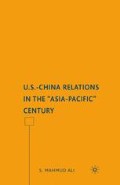Abstract
Taiwan threatened post-Cold War stability, as it had during the 1971–89 U.S.-China “tacit alliance.” In the mid-1990s, tensions mounted, with the potential for a triangular confrontation generating conflict. Taiwan’s silence over Deng Xiaoping’s “one country two systems” formulation for Hong Kong and Macao—also aimed at Taipei—raised the stakes. President Lee Teng-hui adopted an assertive tone before Taiwan’s first legislative elections in December 1995, and presidential polls the following March. In 1994, the PLA conducted a command-post exercise (CPX)—using communication links, but no troops—in which commanders refined joint-services maneuvers aimed at occupying Taiwan if ordered. This exercise provided the template for events that followed.5 In January 1995, Jiang Zemin elaborated Deng’s offer in his “8-point proposal.” After reunification, Taiwan would retain its domestic and foreign economic and technical structures and practices. Exercising “a high degree of autonomy,” Taiwan would maintain legislative and judicial independence “including that of final adjudication.” It would retain its political, administrative, and military institutions; none would be sent from the mainland. Instead, some central posts would be offered to it.6
Certain foreign forces have further meddled in the issue of Taiwan, interfering in China’s internal affairs. All this not only impedes the process of China’s peaceful reunification but also threatens peace, stability and development in the Asia-Pacific region.1
—Jiang Zemin
We have, within a few hundred miles of Taiwan, a carrier, Independence. We have a guided missile cruiser and a guided missile destroyer also nearby. One of the guided missile cruisers is close enough that it actually was the one that observed the missile test and we also have some reconnaissance systems that observed the missile test.2
—William Perry
A week ago I signed the orders directing the deployment of the Independence battle group from Okinawa to patrolling just east of Taiwan. At the same time, I signed an order moving the deployment of the Nimitz battle group from the Gulf of Arabia to join up with the Independence off of Taiwan…. I do not believe that the Chinese have any intention of attacking Taiwan.3
—William Perry
China and the United States are two great nations that have significant differences. Therefore, to develop friendly relations and cooperation between our two countries not only serves the fundamental interests of the two countries, of the two peoples, but they are also of great importance to the maintenance ofpeace and stability in the Asia Pacific region and in the world as a whole.4
—Gen. Chi Haotian
Access this chapter
Tax calculation will be finalised at checkout
Purchases are for personal use only
Preview
Unable to display preview. Download preview PDF.
Notes
Jiang Zemin, Continue to Promote the Reunification of the Motherland, January 30, 1995.
Nicholas Burns, No Determination on Reported China-Pakistan Missile Transfer, State Department, July 5, 1995.
Warren Christopher, US National Interest in the Asia-Pacific Region, State Department, July 28, 1995.
Sutter, China’s Sinister View of US Policy, CRS, June 1995, p. 1.
Lord, US Policy Toward China, State Department, October 11, 1995.
Perry, US Strategy: Engage China, Not Contain It, DoD, October 30, 1995.
James Lilly, Testimony to the Commission on the Roles and Capabilities of the US Intelligence Community, January 19, 1996.
Maj. Gen. Wu Jianguo, “Nuclear Shadows on High-Tech Warfare,” Chinese Military Science, Winter 1995.
Perry, News Briefing, March 8, 1996
Christopher, Interview on “Meet the Press,” March 10, 1996. On movement of U.S. warships, see News Briefing, DoD, March 12, 1996; U.S.-China tensions are in Lord, House testimony, March 14, 1996.
Remarks by the President at Asian -American Pacific Caucus Dinner, May 16, 1996; Remarks by President Clinton to the Pacific Basin Economic Council, the White House, May 20, 1996; Christopher, American Interests and the US-China Relationship, May 17, 1996
John Deutch, The Future of US Intelligence, CIA, July 11, 1995.
Su Qi, “The US Military’s Three Choices on Intervention,” Taiwan de junbei, Beijing, July 1, 1996, posited America could support Taiwan against China by providing “large-scale” military aid, or dispatch forces to warn away or attack PLA units, or deploy naval, air, and ground forces to Taiwan, or attack mainland China—all destined to fail.
James Sasser, Report from Beijing, State Department, April 26, 1996.
Burns, Special Briefing on US-China Discussions, State Department, May 10, 1996.
Harold Johnson, Senate testimony, March 23, 2000.
Charlene Barshefsky, House testimony, June 11, 1996. A positive view is in Engaging with China to Promote US Interests, the White House, July 29, 1996.
David Shambaugh, Political Dynamics in Transitional China, AWC/ ONA, April 23–25, 1996, pp. 2–4.
Li Peng, Main Characteristics of China’s Foreign Policy, FMPRC, September 19, 1996.
Montaperto, China as a Military Power, Washington, NDU, 1995, p. 1.
John Holum, Press Conference, Beijing, ACDA, October 9, 1996.
He Hongze and Zhou Dewu, “Disarmament Lies at a Crossroads,” Renmin ribao, November 1, 1996.
Cui Tiankai, FMPRC, November 5, 1996.
John Gannon, The Outlook for China, CIA, November 20, 1996.
Chi Haotian quoting Jiang Zemin, News Briefing, DoD, December 9, 1996.
Ming Zhang, The Shifting Chinese Public Image of the US, Washington, NDU, November 1996.
Copyright information
© 2008 S. Mahmud Ali
About this chapter
Cite this chapter
Ali, S.M. (2008). Turbulent Times. In: U.S.-China Relations in the “Asia-Pacific” Century. Palgrave Macmillan, New York. https://doi.org/10.1007/978-1-137-11687-1_3
Download citation
DOI: https://doi.org/10.1007/978-1-137-11687-1_3
Publisher Name: Palgrave Macmillan, New York
Print ISBN: 978-1-349-60305-3
Online ISBN: 978-1-137-11687-1
eBook Packages: Palgrave History CollectionHistory (R0)

